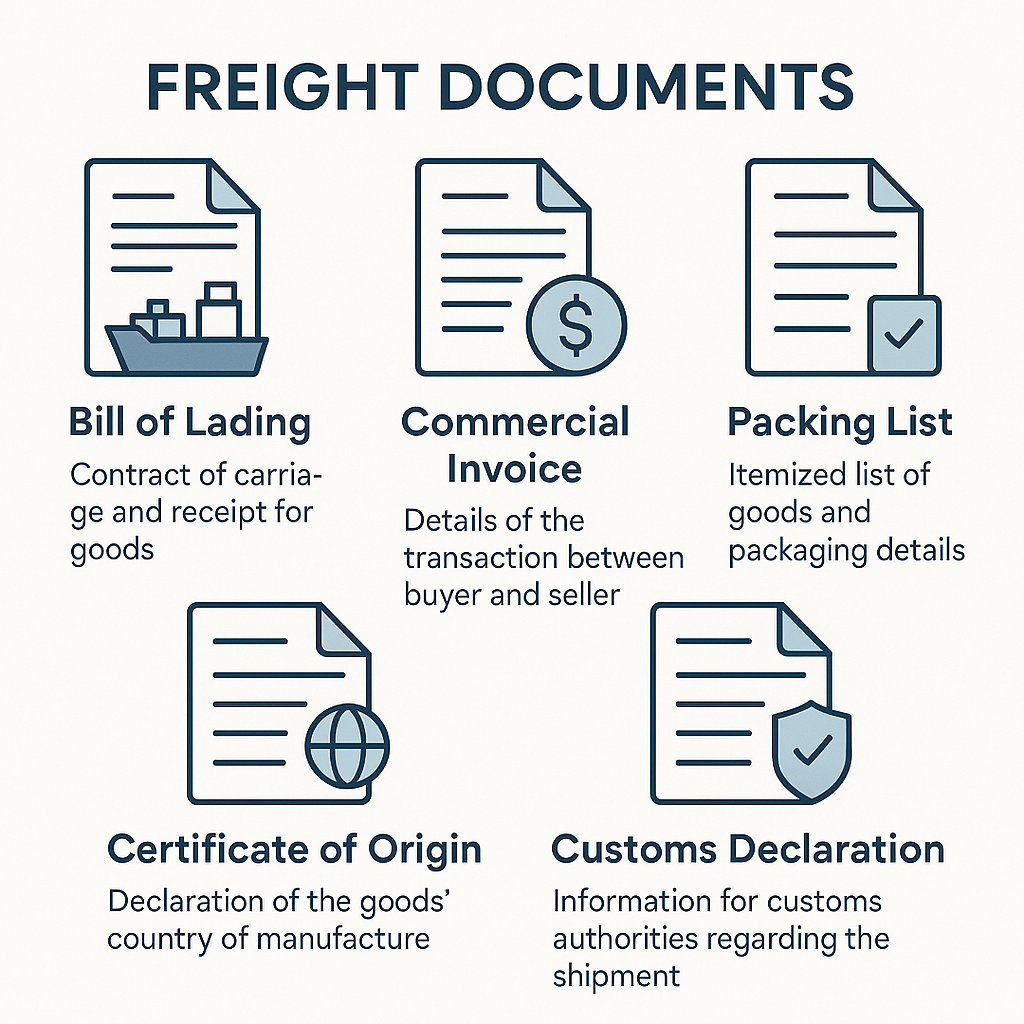In the fast-paced world of global trade, freight documents are the lifeline that keeps cargo moving across borders. They serve as proof of ownership, verify shipping arrangements, and ensure compliance with international trade laws. From a small e-commerce shipment to a full container of machinery, the correct freight documentation is crucial to avoid costly delays and legal complications.
1. What Are Freight Documents?
Freight documents are legal and commercial records used to confirm the details of a shipment, the responsibilities of each party, and compliance with transportation regulations. These documents may be physical papers or digital files, and they play a central role in coordinating the efforts of exporters, importers, freight forwarders, carriers, and customs authorities.
2. Main Types of Freight Documents
| Document Type | Purpose | Mode of Transport | Key Information Included |
|---|---|---|---|
| Bill of Lading (B/L) | Proof of shipment, title to goods, and contract of carriage | Sea, Inland Waterways | Shipper/consignee details, cargo description, terms of carriage |
| Air Waybill (AWB) | Contract for air cargo transportation | Air Freight | Consignor/consignee details, weight, dimensions, flight info |
| Rail Consignment Note | Confirms goods sent via rail | Rail Freight | Origin/destination, cargo type, wagon details |
| CMR Consignment Note | Legal contract for road freight transport | Road Freight | Sender/receiver info, cargo details, Incoterms |
| Packing List | Itemized cargo content | All Modes | Package count, weight, dimensions, HS codes |
| Commercial Invoice | Legal sales record for customs clearance | All Modes | Product value, currency, Incoterms, tax details |
| Certificate of Origin (COO) | Confirms manufacturing country | All Modes | Exporter info, country of origin declaration |
| Insurance Certificate | Proof of cargo insurance | All Modes | Policy coverage, insured value, validity dates |
3. Why Freight Documents Are Important
- Smooth Customs Clearance – Customs officers rely on freight documents to assess duties, taxes, and trade compliance.
- Proof of Ownership & Title – Some documents, like a Bill of Lading, serve as a legal title to the goods.
- Minimized Disputes – In the event of loss, damage, or delays, freight documents provide the legal basis for claims.
- Financial Transactions – Banks often require freight documents for payment processing under Letters of Credit.
- Efficient Supply Chain Flow – Complete documentation ensures minimal bottlenecks in cargo handling.

4. How to Prepare Accurate Freight Documents
- Match All Details: Names, addresses, and cargo descriptions must be consistent across all documents.
- Follow Country-Specific Formats: Some destinations require translated or notarized versions.
- Confirm HS Codes: Ensure products are classified correctly for customs duties.
- Incorporate Incoterms: Clearly indicate who bears transport, insurance, and customs costs.
- Check Deadlines: Submit time-sensitive documents before the cargo arrives.
5. Common Mistakes in Freight Documentation
| Mistake | Consequence | Solution |
|---|---|---|
| Incomplete consignee details | Delays in cargo release | Verify with the buyer before shipping |
| Incorrect weight/dimensions | Freight cost disputes | Use certified weighing and measuring tools |
| Wrong HS code | Over/under payment of duties | Consult the official tariff classification |
| Missing signatures | Document rejection | Double-check authorization before submission |
| Conflicting Incoterms | Misunderstanding of cost liability | Align terms in the sales contract |
Need expert help with freight documents and global shipping compliance? Contact our logistics specialists today for a tailored freight solution that keeps your cargo moving on schedule.
6. Digitalization of Freight Documents
The logistics industry is shifting from paper to electronic freight documents (e-docs) for greater efficiency. Benefits include:
- Reduced Processing Time: Instant sharing between stakeholders.
- Lower Costs: Less paper, printing, and courier expenses.
- Better Security: Encrypted files prevent fraud.
- Environmental Benefits: Supports sustainability goals.
- Real-Time Tracking: Digital systems can integrate with cargo tracking platforms.

7. Best Practices for Managing Freight Documents
- Use a Freight Management System (FMS): Automates document generation and storage.
- Train Staff Regularly: Keep teams updated on international trade rules.
- Backup Data Securely: Maintain both cloud and physical backups.
- Conduct Document Audits: Review for accuracy before cargo departs.
- Work with Experienced Freight Forwarders: They ensure your documents are complete and compliant.
8. Role of Freight Forwarders in Documentation
Freight forwarders act as the bridge between shippers, carriers, and customs authorities. Their tasks include:
- Preparing and reviewing freight documents.
- Ensuring compliance with destination country rules.
- Coordinating with carriers for document issuance.
- Assisting in claims processing using documented evidence.
9.Conclusion
Freight documents are more than just paperwork — they are the foundation of successful global trade. Properly prepared and managed documents ensure smooth customs clearance, protect against disputes, and keep cargo moving efficiently across borders. Whether shipping domestically or internationally, investing time in accurate documentation is one of the most cost-effective ways to prevent delays and reduce operational risks. In a competitive logistics environment, mastering freight documentation is a must for every business involved in shipping.
- Consult TJ China Freight Forwarding for the lowest quote. They will provide you with reliable, cost-effective service.
FAQ:
Q1.Are freight documents standardized globally?
No. Some core documents are recognized internationally, but many requirements vary by country.
Q2.What happens if a freight document has errors?
It can cause delays, fines, or even shipment rejection at the destination port.
Q3.Who issues the Certificate of Origin?
Usually issued by a Chamber of Commerce or designated trade authority.
Q4.Do digital freight documents replace paper copies completely?
Not yet. Some customs offices still require original hard copies.
Q5.How can I reduce errors in freight documents?
Use automated systems, hire experienced staff, and verify all details before submission.
